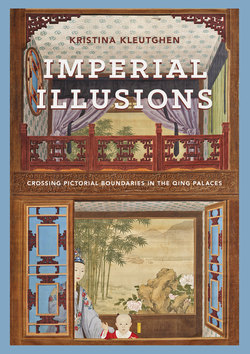Читать книгу Imperial Illusions - Kristina Kleutghen - Страница 71
На сайте Литреса книга снята с продажи.
ОглавлениеAfter the first five pages, which contain two prose prefaces, the remainder of The Study of Vision consists of diagrams inconsistently paired with brief, no-nonsense instructions. Although illustrations therefore make up more than 95 percent of the treatise, previous scholarly attention has focused almost exclusively on translating and interpreting the prefaces. Studies of eighteenth-century Sino-European contact often hint at the connection between The Study of Vision and illusionistic painting, but none engage the entire treatise primarily through its illustrations.4 Most scholarship dedicated to The Study of Vision includes fewer than two illustrations from the treatise, while some include none at all.5 Only three studies in Western languages present more than one or two diagrams, but only one author (and only in the case of two particular illustrations) provides any visual analysis other than the most basic description.6 One Chinese scholar has focused on the illustrations, but is predominantly concerned with architectural drawing and replicating Nian’s diagrams from his textual instructions, actually using the treatise as it was intended.7 Assessments of The Study of Vision are therefore largely grounded in the prefaces, where Nian mentions Giuseppe Castiglione, and the first few diagrams, which are derived from Andrea Pozzo’s Perspectiva, although their accompanying texts are not. Consequently, The Study of Vision is generally seen as a demonstration of “Jesuit perspective,” a reflection of Jesuit influence at the Qing court and therefore of the Jesuit mission itself.8
However, this characterization contradicts the shared conclusion that Nian contextualized linear perspective and Western painting using established Chinese references, and more importantly, ignores the information conveyed in the illustrations. The illustrations do not support a Jesuit reading of the treatise, but rather reflect both Nian’s interest in mathematics, a critical aspect of his identity that is inseparable from The Study of Vision, and the Yongzheng emperor’s own fascination with Western things, which has been overshadowed by his negative treatment of the Jesuits. Without neglecting the prefaces, recentering a discussion of the treatise on its illustrations returns attention to the core of The Study of Vision and to the images that establish its art-historical significance relative to scenic illusion painting.
Nian Xiyao, Practical Mathematician and Expert in Western Things
Nian Xiyao was the oldest son of Huguang (present-day Hubei and Hunan) governor Nian Xialing (1643–1727), younger brother of General Nian Gengyao (1665?–1726), and brother-in-law to the Yongzheng emperor.9 Born in Guangning, Liaoning, within the historic Manchu homeland of northeast China, Nian was a Han-martial (Hanjun) bannerman (baoyi, originally Manchu booi) under the Bordered Yellow Banner, that closest to the emperor.10 This sociocultural identity as a bannerman and imperial bondservant automatically positioned Nian for a career in the Qing bureaucracy. Although the precise dates of his first two official posts are still unknown, Nian began his bureaucratic career under Kangxi as a clerk (bitieshi), a modest term for a common post that was nevertheless
